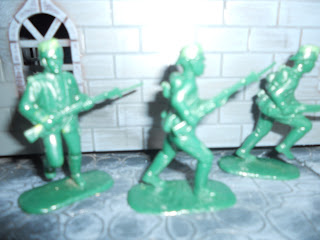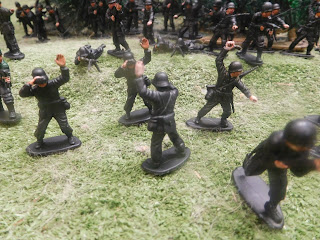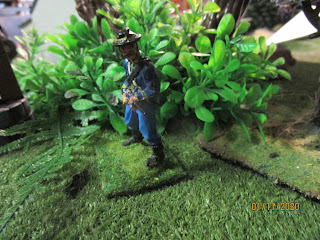Variations On an AIP Japanese Soldier & Historical Accuracy Versus Imagi-Nations
Most military modelers and historical wargamers, if asked, will say they want to achieve a representation of historical accuracy and that might well mean down to the last button on a uniform. I certainly was schooled that way from my later teenage days when I spent a lot of money on books on uniforms. Now with the Internet there are even more references at our fingertips. There is little excuse for major inaccuracies, except perhaps a shortage of time and an eagerness to get troops on to the battlefield.
There are, however, sometimes conflicting references so one can then take one's pick. But no-one, for example, should be fielding US cavalry with blue slouch hats! (Yes, I have seen examples of models painted with such). Less, obviously, nor should they all have yellow neckerchiefs and yellow trouser stripes (unless officers or NCOs).
Having got that out of the way, I'll say, that for many years now, my painting objectives have not been purely historical. Sometimes I want to 'restore' figures to their original colors and toy soldier makers are notoriously inaccurate in their knowledge of historical uniforms!
There is also a matter of convenience. When I conscript every toy knight I can find, into my medieval army I am essentially combining types of armor and even individuals from hundreds of years apart. For this reason, I don't mind too much about making up generic heraldic devices. The knights are going to end up in full blown fantasy campaigns, anyway.
Whilst I want to know what was historical, sometimes I don't WANT to be 100% historical. The example I am going to use is the AIP and Britains hollow-cast Japanese infantryman. AIP provided just what I needed for massed late 19th to early 20th century armies. As I now practice the idea of imagi-nations this gives me some latitude. Most of my imagi-nations correspond to a historical country and so I still start with historical uniforms but might take it into slightly unhistorical directions.
When Britians brought out, in 1905, its hollowcast Japanese infantry to cash in on the Russo-Japanese War it got the uniform almost entirely wrong. The coats are a light blue-grey and the caps have yellow crowns. Realizing their mistake, they issued a new figure the same but with correct dark blue coat, but still with the inaccurate yellow crowned caps. But here's the thing: I so much liked the most inaccurate version that I decided to depict it in one of my Army Cerise regiments!
BELOW: Japanese/Cerisian Infantry with original unpainted figure from AIP
The figure at right needs some PVA or Modge Podge to fix that paint depletion on the cap. The figure at left is a Mexican Revolution Federale. This is somewhat untypical, as the canvas gaiters were not common and bandoleers became more prevalent than boxes, but, in this case, I didn't want to do the conversion work.
My philosophy is that if I want to say something is historical then I endeavor to research correct depiction. Otherwise I make clear that what I am depicting is not 100% historical. Even my copying of 'historical' Britains colors I took some liberties with.
In some future posts I'll show some more pics of complete Japanese/Cerisian units, including the light grey-blue unit and some Mexicans/Cortesians.














Bravo! Well said, Simon
ReplyDeleteMy attitude, whether historical or otherwise, is that if the thing looks like what it's meant to be then that is what it is. There is historical accuracy if you want to depict soldiers, vehicles and equipment in regulation order. But 'regulation order' might well NOT represent historical accuracy, or even verisimilitude. Dye batches vary; weathered uniforms fade and get dirty; the accidents of campaigning require alterations to uniform.
ReplyDeleteThe famous British brick red was notorious not colour fast, and tended to fade into pink. The best painted British Napoleonic army I ever saw gave them pinkish coats.
The Duke of Wellington himself remarked upon the sartorial heterogeneity of his troops in Spain. He was OK about it, so long as the men didn't wear French uniform. Even that caveat was not strictly observed.
The most salutary comment I ever read on the matter was from a Confederate general after the war. During the whole conflict, he precisely once saw a private soldier dressed in immaculate regulation uniform. The uniform was artillery. The man was serving in the infantry...
On the whole, with the exception of Napoleonics and (to some extent) WW2, I tend to the Imagi-Nation school of thought, but with the armies based on recognisably historical counterparts. My 30YW armies of Austeria and Severia are, of course, recognisably those of Imperial Austria and the Kingdom of Sweden (Sverige).
Interesting topic...
Cheers,
Ion
Thanks, that is another factor I forgot to mention- weathering and contingencies of campaign effecting shades of uniforms. Even the French Napoleonic Guard units would begin to look raggedy on campaign.
DeleteDitto! Alan Tradgardland
ReplyDelete